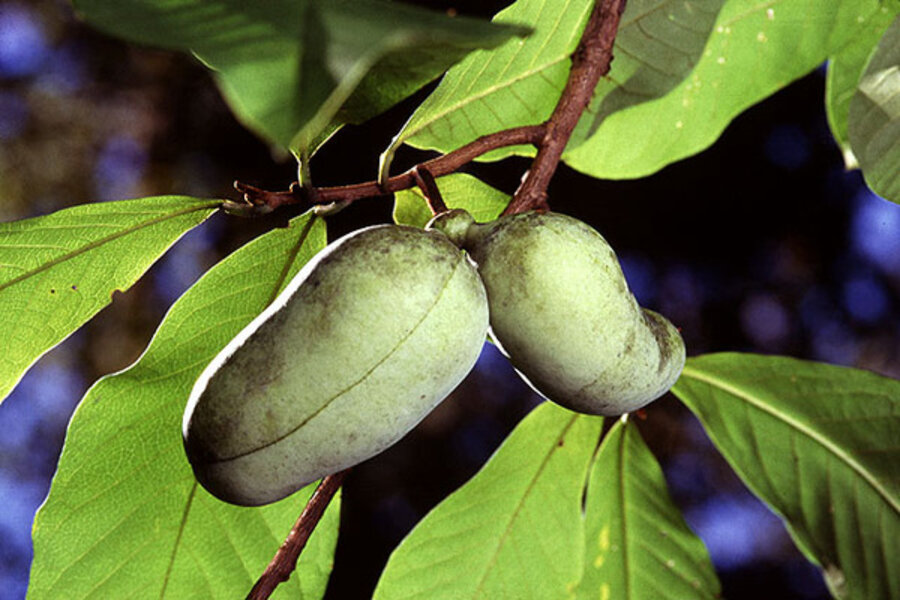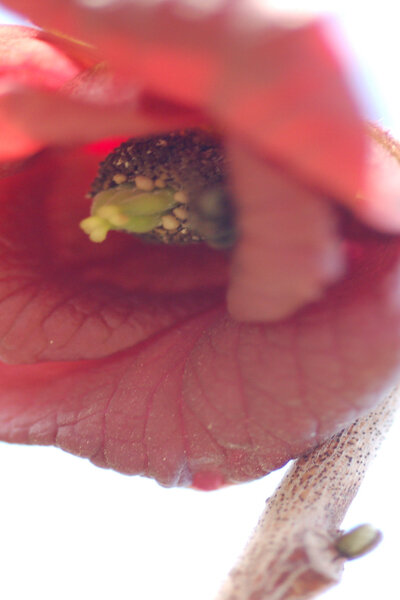The pawpaw's stamp of approval
Loading...
When last we saw John Vukmirovich – the English prof, naturalist, and “professional sandhill crane spotter" – he was a modern-day Johnny Pawpaw Seed, surreptitiously distributing seed of America’s forgotten fruit throughout the Chicago area, even on a Nike missile range.
No longer. He heard that maybe some folks with big offices might frown on his actions.
But he hasn't stopped trying to further gain recognition for pawpaws. This week he is proposing to the US Postal Service that they create a stamp with his favorite fruit on it.
The appeal of an unusual tree
“The guidelines for a proposal are very strict,” he says. “And they say they look at 10,000 proposals a year. So I wanted my proposal to be evocative, something to appeal to the heart, the mind, even the nose.”
He has certainly done that, and here I quote his proposal in full:
"They say that rivers flow down to the sea from the land, but rivers of the imagination flow into the land, and are a part of it, flowing from the Appalachians and the Alleghenies west to the Mississippi, moving in and among the mountains, turning into streams and creeks that glide past and alongside countless ridges and into innumerable hollows, until the waters and the land are inseparable. Alongside those rivers, creeks, and streams, deep in the hollows and on the sides of the ridges, in the shadow of the mountains, grows a tree that like the rivers is a part of the land itself, inseparable: Asimina triloba, the North American pawpaw.
"The flowers of the pawpaw are as visually striking as the fruit is delectable. The purple flowers bloom usually by mid-June. The six-petaled and two-tiered flowers are textured as if cut from crepe paper. The back tier's large petals point to 10, 2, and 6 on the clock face of nature, while front tier's are at noon, 4, and 8. But the effect, accentuated by the yellow, pollen-rich center, is timeless. The purple is deep and rich, as if an artist first laid down a chocolate-colored underpainting, an imprimatura, before applying the purple, the color of the underlayer adding a sweetness, if you will, to the flower's color, if not to the fruit itself.
"Once pollinated, the clusters of light green fruit swell until they are roughly mango-sized and -shaped, their skins irregularly daubed with a patina of brackish purple. Inside, the meat is a creamy yellow that darkens as the fruit matures, and at its peak, has a custard-like consistency, while the fruit as a whole gives off a heady floral aroma. The flavor teases the senses, banana-vanilla up-front, but at times behind that, pineapple or coconut accents, befitting its long droopy tropical leaves. The seeds are large, bean-shaped and a dark chocolate brown.
“For centuries, Americans – from the Indians to the settlers, from George Washington to Thomas Jefferson, from the members of the Lewis and Clark expedition to today's devotees – have harvested and relished pawpaws on late September or early October days. Some consume pawpaws right after being picked, while others puree the meat and fold it into the batter for cakes, cookies and quick breads or blend it into custards, ice cream and smoothies, the last with a healthy splash of dark rum, if your please. Pawpaws are also part of American folk culture, along with crazy quilts, tadpoles in Mason jars, and classic folk tunes such as "Shenandoah," "Barbara Allen," and, of course, "Way Down Yonder in the Pawpaw Patch." Pawpaws belong on back porches on golden September afternoons, at suddenly conceived Indian summer picnics and at the family dinner table after Sunday services with the first hints of autumn in the morning air. Pawpaws belong to the world of red and black-checked wool shirts, dungarees and grandpa's fedora, and where children still read and dream about Daniel Boone, Davy Crockett and Mike Fink, as well as Tom, Huck and Jim. And some varieties of pawpaws are named for some of America's most storied rivers: Allegheny, Potomac, Wabash, Susquehanna, and Shenandoah.
"Hold a booklet of current-issue "forever stamps" in front of you, and instead of a monotonous array of Liberty Bells, imagine an alternating two-stamp depiction of pawpaws, the first focusing on the deep purple flowers with foliage, the second on a cluster of ripened fruit with one in the foreground cut open to reveal the subtle yellow meat and the chocolate-colored seeds: One can almost smell the tropical scent and savor the unique texture of the fruit. One might also well wish it were still necessary to lick a stamp.
"Asimina triloba, the North American pawpaw, has been, and still is, a part of the texture of American folk culture, in food, in music and in history. Pawpaws are found along ridges and in the shadow of mountains, and along creeks and streams that empty into rivers that are part of the land itself, as the pawpaw is of the land itself, inseparable from the land, America."
Surely even a Washington bureaucrat would be touched by this.
What you can do
To keep informed of developments in this process, e-mail pawpawstamp@gmail.com. To add your support, after Labor Day send a postcard to the Citizens’ Stamp Advisory Committee c/o Stamp Development, U.S. Postal Service, 475 L’Enfant Plaza SW, Room 3300, Washington, DC 20260-3501.
What else I’m into this week: Our new puppy, a Bernese Mountain Dog. [See second photo at left; click on arrow at right base of first photo.]
-----
Craig Summers Black, The Transplanted Gardener, is an award-winning garden writer and photographer who blogs regularly at Diggin' it. You can read more of what he's written by clicking here. You may also follow Craig’s further adventures in gardening, music, and rural life on Twitter.







